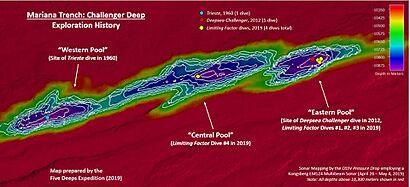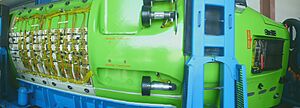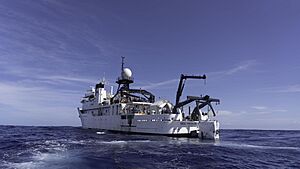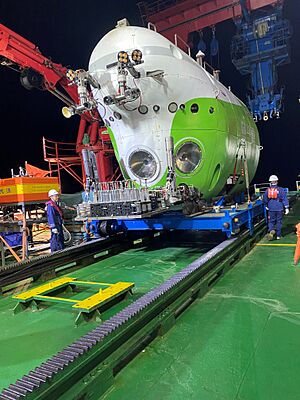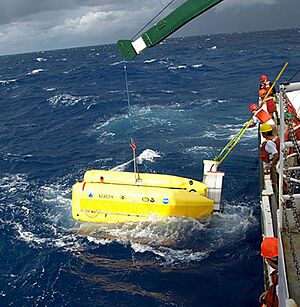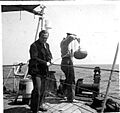Challenger Deep facts for kids
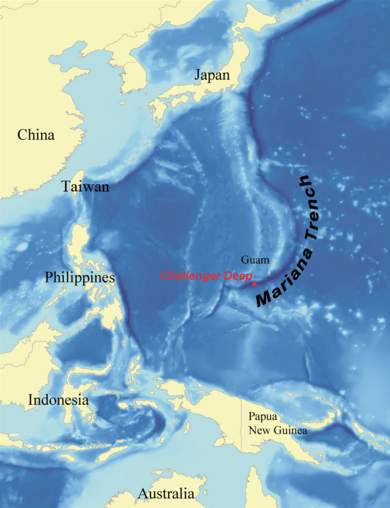
The Challenger Deep is the deepest known part of Earth's seabed. It's found in the western Pacific Ocean, at the southern end of the Mariana Trench. This amazing spot is in the ocean territory of the Federated States of Micronesia. Scientists have measured its depth in different ways. It's usually said to be around 10,920 meters (about 35,827 feet) deep. That's almost 11 kilometers straight down!
This super deep place is named after British Royal Navy ships. The first ship, HMS Challenger, found it between 1872 and 1876. Later, HMS Challenger II confirmed its record-breaking depth from 1950 to 1952. The very first time a vehicle reached the bottom was in January 1960. This was the bathyscaphe Trieste. In March 2012, film director James Cameron made a solo trip down in his special submarine, the Deepsea Challenger. By July 2022, 27 people had visited the Challenger Deep.
Contents
What Does the Challenger Deep Look Like?
The Challenger Deep is like a small, slot-shaped hole. It sits at the bottom of a much bigger, crescent-shaped ocean trench. This trench itself is an unusually deep part of the ocean floor. The Challenger Deep actually has three main parts, or basins. Each basin is about 6 to 10 kilometers (3.7 to 6.2 miles) long. They are about 2 kilometers (1.2 miles) wide. These basins are all deeper than 10,850 meters (35,597 feet).
The basins are lined up from west to east. Small hills, about 200 to 300 meters (656 to 984 feet) high, separate them. The western and eastern basins have been measured as deeper than 10,920 meters (35,827 feet). The middle basin is a little less deep. The closest land to the Challenger Deep is Fais Island, about 287 kilometers (178 miles) away. Guam is about 304 kilometers (189 miles) to the northeast. Recent maps show that the bottom of these basins isn't perfectly flat. It has slopes and piles of rocks, covered by soft ocean mud.
How We Explored the Deepest Point
For many years, scientists have tried to find and study the deepest spot in the world's oceans. It's very hard to measure depths accurately in such deep water. Sound waves, which ships use to map the bottom, can be affected by water temperature and pressure.
First Discoveries (1875 - 1950s)
In 1875, the HMS Challenger was on a long trip around the world. By chance, it sailed over the undersea canyon that became the Challenger Deep. The crew used a weighted rope to measure the depth. They recorded a depth of 4,475 fathoms (about 8,183 meters or 26,847 feet). This was the deepest spot they found on their entire journey. It was amazing luck that the first big ocean science trip found Earth's deepest place!
Seventy-five years later, in 1951, another British ship named HMS Challenger II went to the same area. They used special bomb-soundings and a stronger echo sounder. They found an even deeper spot, measuring 5,940 fathoms (about 10,863 meters or 35,640 feet). This was in the western part of the Challenger Deep. After this trip, the name "Challenger Deep" became official.
In 1957, a Soviet research ship, RV Vityaz, also explored the area. They reported a depth of 11,034 meters (36,201 feet). However, this measurement was later thought to be a bit too high. In 1959, the US research vessel Stranger used explosives to measure the depth. They confirmed a depth of about 10,850 meters (35,597 feet).
Modern Mapping (1980s - Today)
New technology helped scientists get much better maps. In 1984, the Japanese ship Takuyo was the first to use a new type of sonar called a multi-beam echosounder. This allowed them to map a wide area of the seafloor at once. They found the deepest point to be 10,920 meters (35,827 feet) in the eastern basin. This was the first time scientists realized the eastern basin was the deepest.
Many other research vessels have visited the Challenger Deep since then. These include the RV Thomas Washington, RV Kana Keoki, RV Hakuhō Maru, RV Yokosuka, RV Kairei, RV Melville, RV Kilo Moana, USNS Sumner, RV Falkor, USCGC Sequoia, RV Xiangyanghong 09, RV Tansuo 01, RV Sonne, RV Shiyan 3, RV Zhang Jian, RV Kexue 3, RV Shinyo Maru, RV Shen Kuo, and RV Sally Ride. Each of these ships used advanced sonar and navigation systems to create more detailed maps and collect samples. They have helped us understand the shape of the deep and the life that lives there.
Scientists are still working to get the most exact depth measurement. Different studies sometimes show slightly different depths and locations for the deepest point. This is because it's incredibly hard to measure accurately in such extreme conditions.
Amazing Journeys to the Bottom
Many brave explorers and advanced robots have traveled to the Challenger Deep.
People Who Have Dived Down
The Trieste (1960)
On January 23, 1960, the Trieste became the first vehicle to reach the Challenger Deep. It was piloted by Jacques Piccard and US Navy Lieutenant Don Walsh. Their journey down took almost five hours! They spent only about 20 minutes on the seafloor. They had to leave early because a window cracked due to the extreme temperature changes. The Trieste measured the depth at 10,911 meters (35,797 feet).
James Cameron's Deepsea Challenger (2012)
On March 26, 2012, famous film director James Cameron made a solo dive to the Challenger Deep. He used his special submarine, the Deepsea Challenger. His trip down took 2 hours and 36 minutes. He recorded a depth of 10,908 meters (35,787 feet). Cameron had planned to explore for six hours, but a problem with his submarine's arm made him cut the dive short. He spent 2 hours and 34 minutes at the bottom. He said he saw a "gelatinous flat plain" and only small, shrimp-like creatures called amphipods.
The Limiting Factor (2019-2022)
In 2019, explorer Victor Vescovo began a mission to visit the deepest points of all five oceans. His submarine, the Limiting Factor, made several dives into the Challenger Deep. Between April and May 2019, it completed four dives. They measured depths of up to 10,928 meters (35,853 feet).
Vescovo returned in 2020 for the "Ring of Fire" expedition. He made six more manned dives into all three basins of the Challenger Deep. On June 7, 2020, he dived with former US astronaut Kathryn D. Sullivan. On June 20, he dived with Kelly Walsh, the son of Don Walsh from the 1960 Trieste dive. They reached 10,923 meters (35,837 feet) in the western basin.
In 2021 and 2022, Vescovo continued his dives with the Limiting Factor. Many other people joined him, including Richard Garriott, Michael Dubno, Hamish Harding, and Dawn Wright. Wright used a special sonar to map the walls of the Western Pool.
China's Fendouzhe (2020)
In 2020, China's manned submersible Fendouzhe (meaning "Striver") made 13 test dives in the Mariana Trench. On November 10, 2020, three Chinese scientists reached the bottom of the Challenger Deep. They live-streamed their descent and reported a depth of 10,909 meters (35,791 feet). This made Fendouzhe the fourth manned vehicle to successfully reach the deepest point.
Robot Explorers (ROVs)
Kaikō (1996 & 1998)
The Japanese robot submarine Kaikō made many uncrewed dives to the Mariana Trench. In 1996, it reached 10,911 meters (35,797 feet) in the eastern basin. This was the first time a vehicle had visited the Challenger Deep since the Trieste in 1960. Kaikō collected over 360 samples of mud from the trench bottom. Scientists found about 3,000 different tiny living things in these samples. Sadly, Kaikō was lost at sea during a typhoon in 2003.
Nereus (2009)
In 2009, the hybrid robot Nereus explored the Challenger Deep. It could work either connected to a ship or on its own. Nereus spent about ten hours exploring the eastern basin, sending live video back to its support ship. It reached a maximum depth of 10,902 meters (35,768 feet). Nereus collected both mud and rock samples. It was the deepest-diving vehicle in operation at that time. Unfortunately, Nereus was lost in 2014 during a dive in another trench.
Other Robot Dives
Other robot submersibles have also explored the deep. In 2008, the Japanese robot ABISMO tested its abilities near the Challenger Deep. In 2016, China's Haidou-1 dived to 10,767 meters (35,325 feet) in the Mariana Trench. In 2020, the Russian submersible Vityaz-D reached 10,028 meters (32,899 feet). These robots help scientists learn more about the deepest parts of our oceans without risking human lives.
Life in the Deep
Even in the extreme conditions of the Challenger Deep, life exists!
When the HMS Challenger first explored the area in 1875, they found tiny, single-celled organisms called radiolaria in their mud samples.
In 1960, the crew of the Trieste reported seeing a "flatfish" on the seabed. However, many scientists now think it might have been a sea cucumber instead. Robot cameras have since spotted sea cucumbers, scale worms, and shrimp. The Nereus probe even saw a small polychaete worm.
Scientists have found many simple organisms in the mud samples from the Challenger Deep. These include tiny creatures called foraminifera. Most of these have soft shells, which is unusual. This might be because the high pressure in the deep ocean makes it hard for creatures with hard, calcium carbonate shells to grow. Scientists think that as the Challenger Deep got deeper over millions of years, many species couldn't adapt and died out.
In 2013, researchers found that special microorganisms called piezophiles (meaning "pressure-loving") thrive in the Challenger Deep. These tiny living things are incredibly good at adapting to extreme conditions. They can even live inside rocks deep below the seafloor! This shows that life can be found almost anywhere on Earth, even in the most challenging environments.
Images for kids
-
Research vessel Vityaz in Kaliningrad "Museum of world ocean"
See also
 In Spanish: Abismo de Challenger para niños
In Spanish: Abismo de Challenger para niños
- Emden Deep
- Horizon Deep
- Litke Deep, closest point to Earth's center
- Sirena Deep (formerly HMRG Deep)
- List of people who descended to Challenger Deep


